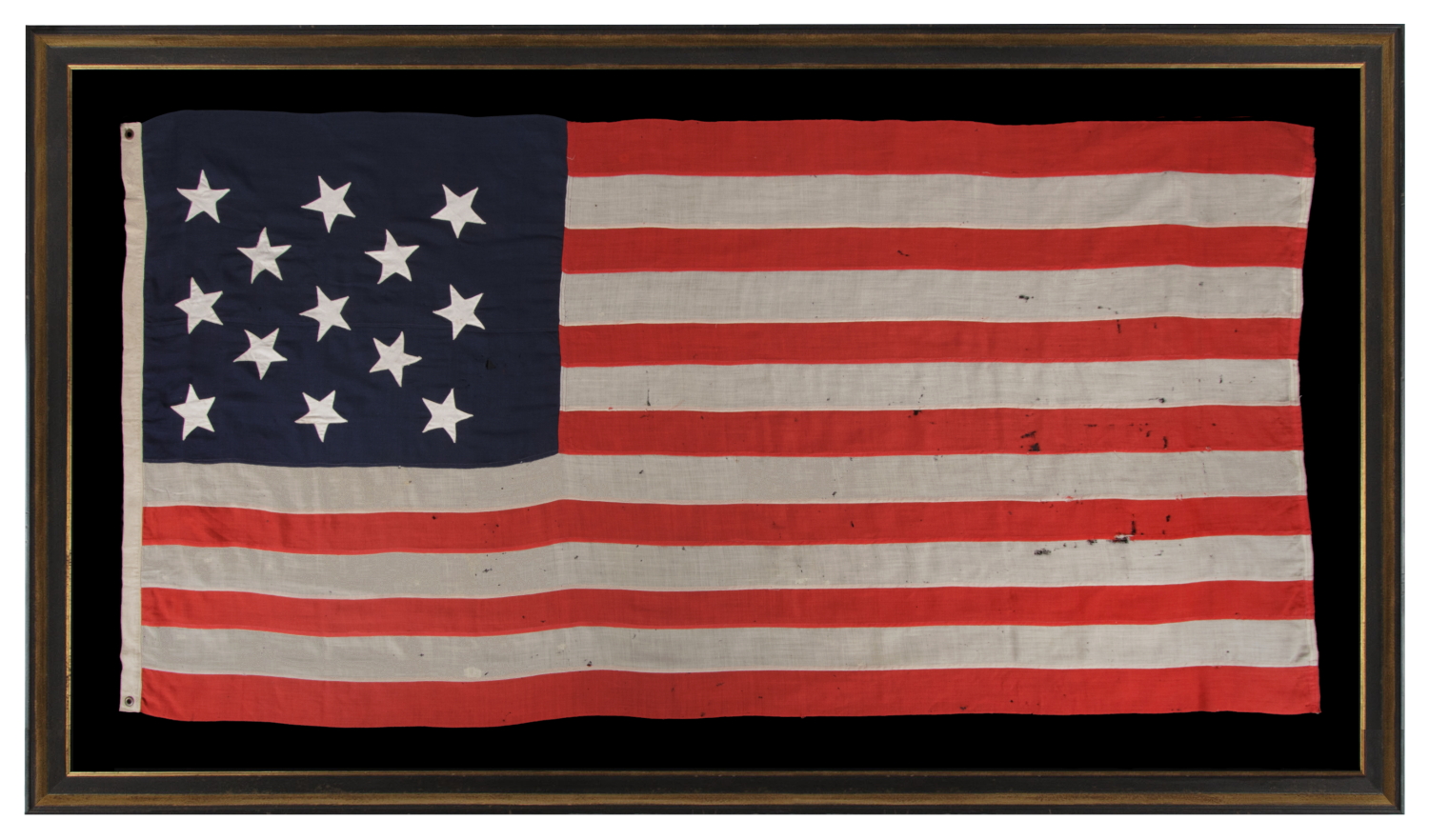
| |
13 STARS IN A 3-2-3-2-3 LINEAL CONFIGURATION, ON A LARGE SCALE ANTIQUE AMERICAN FLAG MADE DURING THE LAST DECADE OF THE 19TH CENTURY |
|
| Available: |
Sold |
| Frame Size (H x L): |
Approx. 65" x 116.5" |
| Flag Size (H x L): |
53" x 104.5 |
|
| Description....: |
|
13 star American national flag, dating to the last decade of the 19th century. The stars are arranged are arranged in staggered lineal rows in counts of 3-2-3-2-3, which is the most common configuration found in 19th century flags with 13 stars. In most cases the 3-2-3-2-3 design can also be viewed as a diamond of stars, with a star in each corner and a star in the very center. It is of interest to note that the 3-2-3-2-3 pattern can also be interpreted as a combination of the crosses of St. Andrew and St. George, which some feel could have been the design of the very first American flag and may identify a link between this star configuration and the British Union Jack. The pattern is often attributed--albeit erroneously in my opinion--to New Jersey Senator Francis Hopkinson, a member of the Second Continental Congress and signer of the Declaration of Independence, who is credited with having played the most significant role in the original design of the American national flag. Hopkinson's original drawings for the design of the flag have not survived and his other depictions of 13 star arrangements for other devices are inconsistent.
Why 13 Stars?
13 was the official count of stars on the first American flag, representing the original 13 colonies. According to the flag acts passed by Congress throughout history, any American national flag that has previously been official, remains so today. For this reason, any 13 star flag that otherwise meets the rudimentary guidelines of the original flag act, is acceptable as an official flag of the United States.
As the number of stars grew with the addition of new states, two circumstances occurred. One, it became more and more difficult to fit stars on a small flag, and two, it became more difficult to view them from afar as individual objects.
Ship captains were keenly aware of this issue. The U.S. Navy used 13 stars on ensigns made for small boats, because they wished the stars to be more easily discerned at a distance. The concept of "small" within Naval signals made during the 19th century basically meant flags measuring 10 feet on the fly or less. Afterwards the scale of the largest small boat ensigns was reduced to approximately 6.5 feet or less. As time progressed, national flags in general, used in both private and public service, became smaller in scale.
When small flags were produced, commercial flag-makers often applied the same logic as the Navy, selecting the 13 star count, rather than the full complement of stars, for the sake of ease and visibility. This particular flag was privately manufactured by a commercial maker in the period between roughly 1890 and 1900. Measuring just under 9 feet on the fly, it is unusually large for the period among surviving 13 star examples. Practically all commercially-made flags of this scale, made during this era, would have a canton that contained the full complement of stars.
13 star flags have been used throughout our nation’s history for a variety of purposes. In addition to their use by the Navy and commercial makers on small scale flags, they were produced for patriotic events, such as the annual observance of Independence Day. They were flown by politicians when campaigning for office, and hoisted on private ships. The Navy's use of the 13 star count on small boats officially ended in 1916 following an executive order of President Woodrow Wilson.
Construction: The flag is entirely treadle sewn with a wool canton and stripes, complimented by double-appliquéd cotton stars that are sewn with a lineal stitch. There is a heavy twill cotton binding along the hoist, with 2 brass grommets, along which are two pencil inscriptions. One is partially illegible, but appears to contain the letters "B" and "K". This probably indicates the name of a former owner or a factory designation of some sort. The other reads "4 x 9" to indicate size in feet.
Mounting: The flag has been mounted and framed within our own conservation lab, which is led by expert staff. We take great care in the mounting and preservation of flags and have framed thousands of examples.
The background is 100% cotton twill, black in color. The black-painted, hand-gilded and distressed molding has a wide, serpentine profile and is Italian. The glazing is U.V. protective plexiglass.
Condition: There is minor mothing throughout, accompanied by a couple of areas of moderate mothing. There is very minor soiling in limited areas. Many of my clients prefer early flags to show their age and history of use. |
|
|
|
| Collector Level: |
Intermediate-Level Collectors and Special Gifts |
|
| Flag Type: |
Sewn flag |
|
| Star Count: |
13 |
|
| Earliest Date of Origin: |
1890 |
|
| Latest Date of Origin: |
1899 |
|
| State/Affiliation: |
13 Original Colonies |
|
| War Association: |
|
|
| Price: |
SOLD |
|
| |
Views: 1405 |
|
|
|

